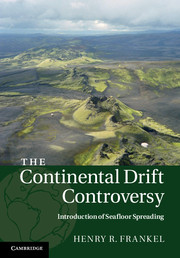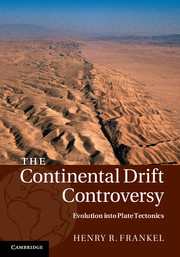For many, the theory of continental drift is a proven and understood concept. Few are aware that the debate has been decades-long process. A recently published, multi-volume book is re-going through the whole story on how the theory evolved, detailing the views of how scientist perceived it over time.
The debate is between fixism and mobilism which the author, Henry R. Frankel, describes in a three-phase process. “Fixism was almost universally assumed until Frank Taylor in 1910 and Alfred Wegener in 1912 introduced their mobilist theories of continental drift and inaugurated the first or classical phase“. The second phase of the controversy, the subject of Volume II, is marked by the rise in the early 1950s of paleomagnetism. The third and final phase of the controversy, the subject of Volume III, began in the mid-1950s when there was a massive influx of new information about the seafloor obtained through the use of new geophysical techniques and instruments. This phase began in earnest about a decade after World War II and intensified during the early stages of the Cold War. Volume IV is about the evolution into plate tectonics
Cambridge.org describes the book as “the first complete history of the origin, debate and gradual acceptance of this revolutionary theory” on the continental drift controversy, “based on extensive interviews, archival papers and original works. Frankel weaves together the lives and work of the scientists involved, producing an accessible narrative for scientists and non-scientists alike. This first volume covers the period in the early 1900s when Wegener first pointed out that the Earth’s major landmasses could be fitted together like a jigsaw and went on to propose that the continents had once been joined together in a single landmass, which he named Pangaea.”
- The most thorough account ever written of the most fundamental theory in the geosciences
- Includes material from first-hand interviews with many of the leading scientists involved
- Frankel’s accessible writing style will appeal to Earth scientists of all disciplines, as well as historians and philosophers of science
Author:
Henry R. Frankel, University of Missouri, Kansas City was awarded a PhD from Ohio State University in 1974 and then took a position at the University of Missouri, Kansas City where he became Professor of Philosophy and Chair of the Philosophy Department (1999–2004). His interest in the continental drift controversy and the plate tectonics revolution began while teaching a course on conceptual issues in science during the late 1970s. The controversy provided him with an example of a recent and major scientific revolution to test philosophical accounts of scientific growth and change. Over the next thirty years, and with the support of the United States National Science Foundation, the National Endowment for the Humanities and the American Philosophical Society, Professor Frankel’s research went on to yield new and fascinating insights into the evolution of the most important theory in the Earth sciences.





Pingback: Bizarre New Study Suggests Octopuses Came From Outer Space – MaxaPost
Pingback: Bizarre New Study Suggests Octopuses Came From Outer Space – Things To Wow
Pingback: Bizarre New Study Suggests Octopuses Came From Outer Space – Drama Palooza
Pingback: Bizarre New Study Suggests Octopuses Came From Outer Space | AmaNews Info
Pingback: Bizarre New Study Suggests Octopuses Came From Outer Space | Diet & Weight Loss